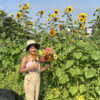Thanks for all your positive feedback about the interview! CBC radio is a hive of activity at 5:30 am and it was amazing to be there. Matt Galloway is very keen on the high-rise growing idea (as are we), so here are a few ideas that may help. If they can grow food on the top of the Fairmont Hotel, so can you! There was not time to discuss the specifics of balcony growing, so read on if interested.
High-rise growing
Balconies and terraces tend to be hot and windy. On the other hand, they get lots of light and you don’t have to deal with raccoons and squirrels. If you are really high up (lucky you, what a view) anything that requires pollination may not do well, bees don’t fly that high.
Planters
- Use the largest pot you can so the roots will have space, and you won’t need to water as much
- Insulate the pot so your plants can withstand the winter, or just buy annual food plants. Some of the resin planters have a double wall which acts as insulation
- A light coloured pot will stay cooler in summer, and be less subject to freeze/thaw cycles in winter
- Be sure that your balcony or terrace can take the weight you are putting on it
Water
- Plants dry out faster in a pot, so consider low-tech slow drip irrigation; Lee Valley has some that just screw onto a bottle and keep your new plants watered, or you can just punch a small hole in the bottom of a bottle and let it drip slowly. You should fasten it to something so it doesn’t blow away when empty
- You do have to water almost every day for potted plants unless it rains, especially if you are in full sun. Mulch is very helpful to shade the soil.
- If your plants look stressed, misting the leaves can help them recover quickly
Soil
- Use good earth, and organic fertilizers. If you have the space, consider a worm composter to turn your scraps into plant food (such as cathyscomposters.com). We do not recommend city compost for food plants, though it’s fine for ornamentals.
- Feed your plants occasionally with organic fertilizers
- Change the soil every once in a while, or throw some worms in, in spring
Plants
- Pollination can be a challenge if you are more than 6 stories up, but if your building has a lot of roof gardens, you may be visited by pollinators
- Easiest plants are strawberries (well-mulched, full sun and regularly watered) and herbs.
- Small bushes such as currants can grow on balconies, they are pretty tough, look good, and can take some shade. They are quite nice looking plants, too. Gooseberries are a bit thorny, so not great for a small balcony.
- Haskaps are quite tough and are worth trying. Remember you need two different varieties for pollination; the Cinderella we sell is not as tasty but is required to pollinate the delicious Borealis. They are nice-looking shrubs too, and can be pruned to stay smaller.
- Grape vines are pretty, and pretty tough, but you do have to prune them or they will get too rampant. Best on a trellis or arbour.
- Blackberries are great, but they are an unruly plant and attract wasps later in the season. Worth trying on a larger terrace, away from sitting areas. We sell the thornless variety
- Raspberries are not a great choice because they are tall and prickly, and not all that attractive
- Hazelnuts would be worth trying; and they are wind pollinated. Again, you need to get two. They are attractive plants, and will grow to a small tree in time.
- Amelanchiers are a great choice – decorative in all seasons, and the fruit is small so it won’t make a mess. It is a multi-stemmed tall shrub or small tree that can take some shade. Will not do well in full shade.
- Fruit trees are possible on roofs and terraces, but truly, they are more challenging because of the wind and their large size. Also, you need two different varieties for pollination. One way to grow them is as an espalier, but that is for the advanced gardener.
Start with a few things and see how it grows. Good luck and let us know what works for you so we can get more balcony-worthy plants in future.



